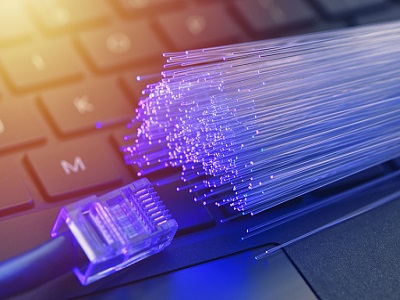

Fiber-optic technology transmits data by light impulses via strands of glass or plastic. The benefits of fiber-optic broadband are numerous and substantial. It provides far more speed and bandwidth than older copper-based systems such as DSL or cable. Fiber's tremendous data-carrying capacity makes it perfect for today's data-intensive applications, ranging from high-definition streaming to online gaming.
The fast construction and growth of fiber-optic networks is one of the most visible trends in the broadband technology landscape. Telecommunications firms, governments, and even local governments are investing in the construction and expansion of fiber-optic infrastructure. This expansion intends to provide high-speed internet to previously unserved or underserved communities, bridging the digital divide and ensuring that more people can reap the benefits of fiber.
Gigabit internet, which can provide rates of up to 1,000 megabits per second (Mbps), is becoming more widely available in many areas. Gigabit connections are transforming the way we work, stream, and interact, with nearly no latency. Furthermore, the trend is not limited to gigabit speeds; numerous locations are also investigating multi-gigabit and 10-gigabit offers, bringing up new possibilities in virtual reality, telemedicine, and other fields.
Fiber-optic deployment technologies such as FTTH and FTTP bring fiber-optic connections directly to households and businesses. These solutions have grown in favor because they provide end consumers the most robust and dependable internet experience. FTTH and FTTP ensure that consumers reap the full benefits of fiber-optic technology without experiencing signal deterioration or having to share capacity with neighbors.
The deployment of 5G networks, the most recent generation of mobile communication, is inextricably linked to fiber-optic infrastructure. 5G tiny cells, which carry wireless signals, need high-speed backhaul connections, with fiber optics being the preferred option. This 5G-fiber convergence is viewed as a critical enabler for smart cities, IoT applications, and mobile connectivity advancements.
Bridging the urban-rural digital gap is a top goal in many nations. Fiber-optic deployment into rural regions has the potential to greatly improve inhabitants' quality of life while also stimulating economic growth. Government programs, subsidies, and public-private partnerships are critical to getting fiber technology to rural areas.
Sustainable internet is gaining popularity as the globe becomes more cognizant of its environmental impact. Fiber optics are regarded as an ecologically beneficial option. They are low energy, emit little electromagnetic disturbance, and have a long lifespan. Fiber broadband is environmentally friendly, which corresponds with worldwide initiatives to reduce carbon footprints and electronic waste.
Countries all across the world are discovering the value of keeping connected in the digital era. Several projects and strategies are being implemented to enhance ubiquitous broadband access. These projects aim to promote not just domestic connection but also international connectivity and collaboration.
In conclusion, fiber-optic technology is at the forefront of contemporary broadband technology events and developments. It offers superfast internet speeds, nearly unlimited capacity, and the ability to change the way we live, work, and communicate. The fast growth of fiber-optic networks, gigabit internet speeds, and the confluence of 5G and fiber are some of the notable themes that promise a hopeful future for broadband technology. The world is moving toward a more connected, inclusive, and environmentally responsible digital future, with an increasing emphasis on green and sustainable broadband, rural connection, and global efforts. As these trends grow, they have the potential to transform the way we interact with and benefit from technology, pushing the frontiers of what is possible.
Visit our website https://nextelle.co.nz/.
#broadband #network #Internet #NBNNews #UnlimitedNBN #BusinessNBN #HomeNBN #Internetconnection #Internetconnectivity #NextelleWireless











